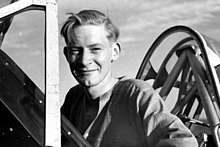David Ince
David Henry Gason Ince DFC (23 March 1921 – 2 August 2017) was a Royal Air Force pilot of the Second World War in Hawker Typhoons who flew nearly 150 sorties and was awarded the Distinguished Flying Cross. He flew the only raid in Europe to use Napalm near Arnhem in April 1945. In 1958 he flew an Olympia 419 glider from Lavenham, Suffolk, to Land's End, a distance of 315 miles and a UK glider distance record at that time.[1][2][3]
David Henry Gason Ince DFC | |
|---|---|
 | |
| Born | 23 March 1921 Glasgow, Scotland |
| Died | 2 August 2017 Winchester, England |
| Allegiance | United Kingdom |
| Service/ | Army; Royal Air Force |
| Battles/wars | Second World War |
Early life
Ince was born on 23 March 1921 in Glasgow to Douglas Ince, who was the director of an armaments firm which supplied Explosives for civil engineering, and his mother Isobel. He was educated at Kelvinside Academy, Aysgarth School and Cheltenham College.[2]
Military career
Enlistment and Training
Ince first experienced flying when he was taken up over the River Clyde by a member of the Renfrew Flying Club in a Gypsy Moth. After school he applied to join the Royal Air Force but failed the eye test. However, he was able to join No. 602 Auxiliary Squadron and found that 18 months' commissioned service with the British Army he could be seconded to the air force. He successfully passed the eye test for the secondment and went to Canada for his flight training.[2]
Second World War
During the Allied Invasion of Europe, Ince's reconnaissance aircraft was hit while he photographed the Gestapo Headquarters at Rotterdam in the Netherlands. In this period he also assisted in the destruction of a bridge that collapsed into the river in one piece. Ince also claimed one-eleventh of a kill in the shooting down of a Blohm and Voss Flying boat.[2]
Napalm
Ince participated in what is thought to be the only operational use of napalm in the European campaign. On 12 April 1945, napalm was used against a German strong point near Arnhem in the Netherlands. The eight-foot canister of napalm missed the target but is believed to have damaged the morale of the German troops. Of the attack Ince noted -[2]
The fiery mass sprayed forward and upwards, in a cascade of incandescent reds and yellows which threatened to engulf my tail.
Typhoon
Ince was enthusiastic to fly the Hawker Typhoon and told a wing-commander who was recruiting pilots to fly them that a shortened right index finger made flying British aircraft easier than American models. This was due to British aircraft employing a spade grip control stick with thumb activated firing button while American aircraft required the pilot to pull levers and press to fire with a finger. The wing commander readily accepted, with an attrition rate of one in three (150 of the 450 Typhoon pilots would be lost by the war's end) he was wondering how to persuade pilots to volunteer.[2]
The shortened index finger, which he dubbed 'Stumpy', was the result of placing it in the Spokes of a bicycle to see what would happen at the age of around seven.[2]
Flying with 193 Squadron and 257 Squadron, Ince flew almost 150 Sorties. When flying reconnaissance he modified the front gun mouldings to take an F24 camera, an exercise which yielded unprecedented close up images.[2]
Post War
Empire Test Pilots' School and Gliding
After the war Ince joined the Empire Test Pilots' School. However, chronic sinusitis prevented his working with high altitude jet aircraft. Ince then turned his attention to gliding and he set a British distance record for gliding with a flight of 315 miles from Lavenham in Suffolk to Land's End in Cornwall.[2]
Civilian Work
Ince worked as an aviation expert for Elliotts, a company specialising in flight systems used in the Lightning and Buccaneer military jets and subsequently Concorde.[2]
Author
Ince penned two books, Combat and Competition in 1992 and Brotherhood of the Skies in 2010.[2]
Personal life
He married Anne Burton in 1954 with whom he had two daughters, Virginia and Rosalind. Ince enjoyed fly-fishing for trout and was a sought after, after dinner speaker. Anne passed away in 1993 and David died on 2 August 2017 at Winchester in Hampshire. He was survived by his two daughters.[2]
Publications
- Combat and competition. Newton Publishers, 1992. ISBN 1872308325
- Brotherhood of the skies: Wartime experiences of a gunnery officer and Typhoon pilot. Grub Street, 2010. ISBN 978-1906502645
References
- "Flt Lt David Ince DFC » Hawker Typhoon RB396". hawkertyphoon.com. Retrieved 26 August 2017.
- "Obituary: David Ince, Second World War fighter pilot". The Scotsman. Retrieved 26 August 2017.
- "David Ince | Register". The Times & The Sunday Times. Retrieved 26 August 2017.
External links
- "Test & Research Pilots, Flight Test Engineers: Flt Lt David Ince DFC". thetartanterror.blogspot.co.uk. Retrieved 26 August 2017.
- "WWII Hawker Typhoon Pilots visit RAF Coningsby". raf.mod.uk. Retrieved 26 August 2017.